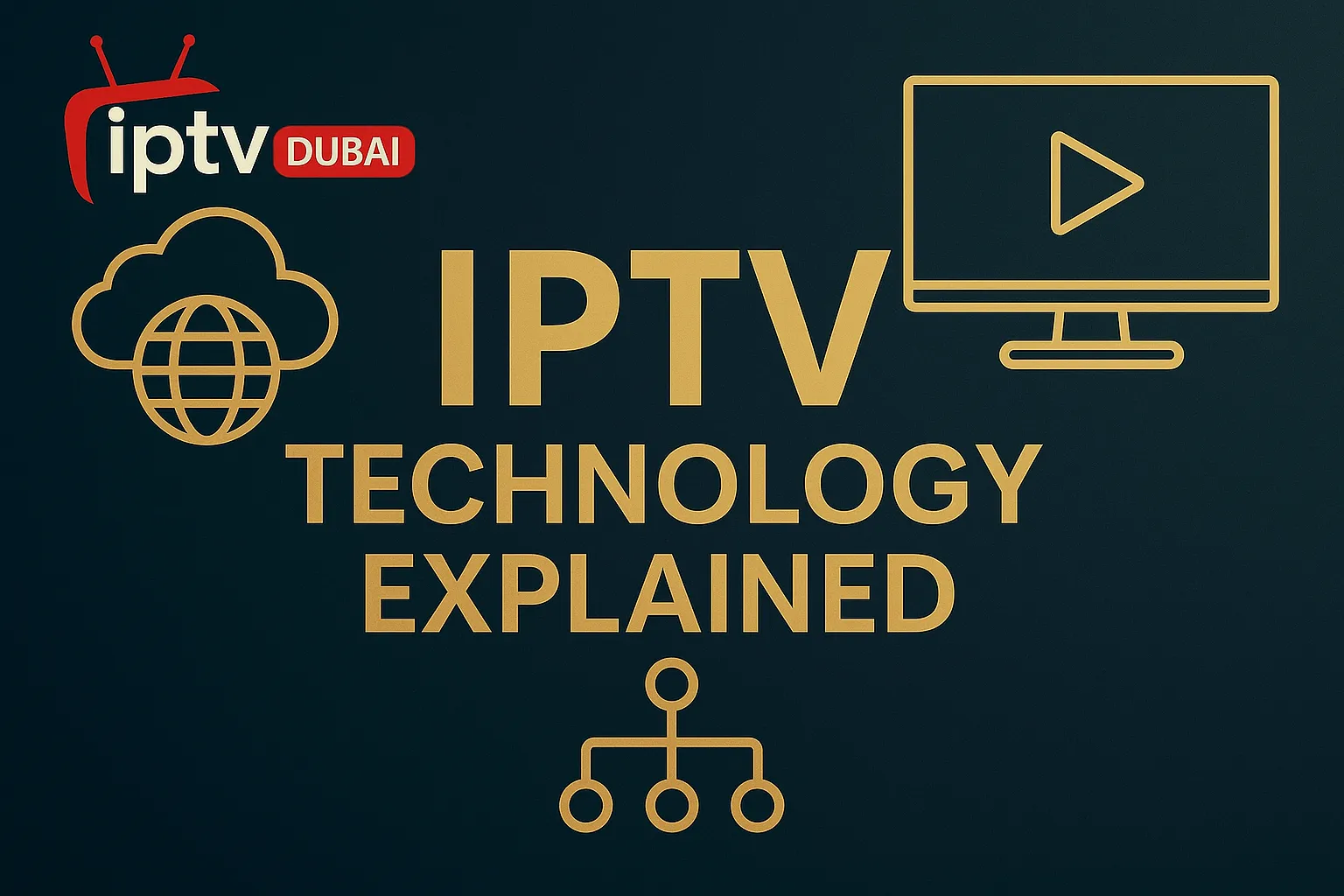Blog
IPTV Technology Explained

IPTV Technology Explained: The Complete Guide to Internet Protocol Television
Internet Protocol Television (IPTV) has revolutionized how we consume television content, transforming traditional broadcasting into a sophisticated digital streaming experience. As streaming services continue to dominate the entertainment landscape, understanding IPTV technology becomes crucial for both consumers and businesses seeking modern television solutions.
Understanding IPTV
Definition of IPTV
Internet Protocol Television, is a digital television broadcasting protocol that delivers television content through internet networks rather than traditional terrestrial, satellite, or cable television formats. Unlike conventional broadcasting methods, IPTV uses internet protocol (IP) networks to transmit video content directly to viewers’ devices, enabling a more personalized and interactive television experience.
This technology allows service providers to deliver TV channels, movies, and on-demand content through broadband internet connections, making television accessible on various devices including smart TVs, set-top boxes, computers, and mobile devices. IPTV represents a significant shift from traditional broadcast television to internet-based content delivery systems.
How IPTV Works
IPTV operates through a complex network infrastructure that converts television signals into digital data packets transmitted over IP networks. The process begins at content servers where television programs, movies, and live TV channels are stored and processed. These servers encode video content into digital formats suitable for internet transmission.
When viewers request content through their IPTV subscription, the service provider’s servers deliver the requested video content through broadband internet connections. Set-top boxes or compatible devices decode these digital signals, converting them back into viewable television content. This streaming service architecture enables real-time content delivery and supports interactive features that traditional television cannot provide.
The technology utilizes various streaming protocols to ensure smooth content delivery, managing bandwidth requirements efficiently while maintaining video quality. Advanced IPTV systems incorporate content delivery networks (CDNs) to optimize streaming performance and reduce latency issues across different geographical locations.
Components of IPTV
Live TV
Live TV represents the traditional television viewing experience within IPTV systems, delivering real-time television broadcasts through internet protocols. Service providers transmit live TV channels simultaneously to multiple subscribers, maintaining the familiar linear television format while leveraging internet infrastructure for content delivery.
Modern IPTV live TV services offer extensive channel lineups, including local broadcasts, international channels, and specialized content categories. The technology supports high-definition streaming and enables features like electronic program guides (EPG), channel surfing, and multi-screen viewing capabilities that enhance the traditional television experience.
Video on Demand (VOD)
Video on Demand services form a cornerstone of IPTV technology, providing subscribers with extensive libraries of movies, TV shows, and specialized video content accessible at any time. VOD platforms store content on servers, allowing viewers to browse, select, and stream desired programs according to their schedules.
IPTV VOD services typically categorize content by genre, release date, popularity, and user preferences, creating personalized viewing experiences. Advanced VOD systems incorporate recommendation algorithms, user ratings, and social features that help subscribers discover new content while maintaining extensive on-demand content libraries.
Time-Shifted TV
Time-shifted TV functionality allows viewers to pause, rewind, fast-forward, and record live television broadcasts, providing unprecedented control over television viewing experiences. This IPTV component stores live TV content temporarily on servers or local devices, enabling viewers to manipulate broadcast timelines according to their preferences.
Features like catch-up TV, start-over functionality, and cloud-based DVR services exemplify time-shifted TV capabilities within IPTV systems. These services eliminate scheduling conflicts and enable viewers to access missed programs within specified time windows, typically ranging from several hours to multiple days after original broadcasts.
Evolution of IPTV
From ADSL to High-Definition Streaming
IPTV technology has evolved significantly since its early implementations over ADSL (Asymmetric Digital Subscriber Line) networks. Initial IPTV services faced bandwidth limitations that restricted video quality and channel capacity, often delivering standard-definition content with occasional buffering issues.
The transition to fiber-optic networks and improved broadband infrastructure enabled high-definition streaming, supporting 1080p and eventually 4K video content. Modern IPTV systems leverage advanced compression technologies and adaptive streaming protocols that automatically adjust video quality based on available bandwidth, ensuring optimal viewing experiences across various network conditions.
This evolution has transformed IPTV from a basic television alternative into a comprehensive entertainment platform capable of delivering cinema-quality content to homes worldwide. Enhanced bandwidth capabilities now support multiple simultaneous streams, enabling households to access different content on various devices concurrently.
Technological Advancements in IPTV
Recent technological advancements have significantly enhanced IPTV capabilities, incorporating artificial intelligence, machine learning, and cloud computing technologies. Modern IPTV platforms utilize AI-powered recommendation engines that analyze viewing patterns to suggest relevant content, improving user engagement and satisfaction.
Cloud-based IPTV infrastructure has eliminated many traditional hardware limitations, enabling scalable content delivery and reducing deployment costs for service providers. Advanced streaming protocols now support ultra-low latency transmission, making IPTV suitable for live sports broadcasting and real-time interactive applications.
Integration with smart home technologies, voice control systems, and mobile applications has expanded IPTV accessibility, allowing seamless content access across multiple devices and platforms. These advancements continue to blur the lines between traditional television and internet-based entertainment services.
Applications of IPTV
Home Entertainment
IPTV has transformed home entertainment by providing comprehensive television solutions that combine live TV, on-demand content, and interactive features within single platforms. Families can access vast content libraries, including movies, TV shows, documentaries, and specialized programming tailored to different age groups and interests.
Smart TV integration enables direct IPTV access without additional hardware, while set-top boxes provide enhanced functionality for older television models. Multi-room solutions allow content sharing across different household locations, enabling personalized viewing experiences for individual family members while maintaining centralized subscription management.
Business Communications
Businesses increasingly utilize IPTV technology for internal communications, training programs, and corporate broadcasting. IPTV systems enable companies to distribute live presentations, training videos, and corporate announcements across multiple locations simultaneously, reducing communication costs and improving information dissemination efficiency.
Corporate IPTV solutions support interactive features like video conferencing integration, employee feedback systems, and real-time polling capabilities. These applications enhance employee engagement and enable more effective corporate communication strategies, particularly for organizations with distributed workforces or multiple office locations.
Educational Uses
Educational institutions leverage IPTV technology to deliver distance learning programs, campus-wide broadcasts, and interactive educational content. Universities and schools use IPTV systems to stream lectures, distribute educational videos, and provide students with access to extensive academic content libraries.
IPTV enables innovative teaching methodologies, including virtual classrooms, interactive learning modules, and on-demand access to recorded lectures. Students can review course materials at their own pace while educators can reach broader audiences through internet-based content delivery systems.
Healthcare Integration
Healthcare organizations implement IPTV solutions for patient entertainment, medical training, and institutional communications. Hospitals use IPTV systems to provide patients with television entertainment, educational health content, and communication tools that enhance the healthcare experience.
Medical professionals utilize IPTV for continuing education, surgical procedure broadcasts, and telemedicine applications. These systems support high-quality video transmission required for medical training and enable healthcare institutions to share expertise across different locations efficiently.
Advantages of IPTV
Interactivity and User Control
IPTV technology provides unprecedented interactivity and user control compared to traditional television broadcasting. Viewers can pause, rewind, and fast-forward content, create personalized channel lists, and access detailed program information through interactive electronic program guides.
Advanced IPTV systems support features like multi-angle viewing for sports events, interactive advertising, and real-time social media integration. These capabilities transform passive television viewing into engaging, interactive experiences that adapt to individual viewer preferences and behaviors.
Accessibility and Global Reach
IPTV eliminates geographical limitations associated with traditional broadcasting, enabling global content access through internet connections. International viewers can access home country programming while traveling, and content providers can reach worldwide audiences without traditional broadcasting infrastructure investments.
The technology supports multiple language options, subtitle capabilities, and accessibility features for viewers with disabilities. Cloud-based IPTV services enable content access from any location with adequate internet connectivity, providing unprecedented flexibility for modern viewing habits.
Service Convergence
IPTV enables service convergence by combining television, internet, and telephone services through single network infrastructures. This convergence reduces costs for both service providers and consumers while simplifying service management and technical support requirements.
Integrated IPTV solutions support unified billing, single customer support contacts, and seamless service integration that enhances overall user experiences. Service providers can offer comprehensive communication and entertainment packages that meet diverse customer needs through consolidated platforms.
Challenges Facing IPTV
Latency Issues
Latency remains a significant challenge for IPTV services, particularly for live TV broadcasts and real-time interactive applications. Network delays can cause synchronization issues between audio and video streams, affecting viewing quality and user satisfaction.
Service providers continuously work to minimize latency through advanced streaming protocols, content delivery network optimization, and edge computing implementations. However, internet infrastructure limitations and network congestion can still impact IPTV performance, especially during peak usage periods.
Bandwidth Requirements
IPTV services require substantial bandwidth to deliver high-quality video content, particularly for high-definition and 4K streaming. Households with multiple simultaneous streams may experience performance issues if internet connections cannot support combined bandwidth requirements.
Internet service providers must continuously upgrade network infrastructure to support growing IPTV demand, while consumers may need to upgrade their broadband subscriptions to access premium IPTV services. Bandwidth limitations can restrict content quality and limit the number of concurrent streams available to subscribers.
Privacy and Security Concerns
IPTV systems face various privacy and security challenges, including content piracy, unauthorized access, and data protection issues. Service providers must implement robust security measures to protect copyrighted content and subscriber information from unauthorized access.
Encryption technologies, secure authentication systems, and digital rights management (DRM) solutions help address these concerns, but evolving cyber threats require continuous security updates and monitoring. Privacy regulations also require IPTV providers to implement comprehensive data protection measures and transparent privacy policies.
Selecting an IPTV Provider
Reliability and Service Quality
When choosing an IPTV provider, reliability and service quality should be primary considerations. Evaluate providers based on uptime statistics, streaming quality consistency, and customer support responsiveness. Reliable IPTV services maintain consistent performance during peak usage periods and provide prompt technical support when issues arise.
Research provider infrastructure capabilities, including server locations, content delivery networks, and backup systems that ensure continuous service availability. Quality IPTV providers offer service level agreements (SLAs) that guarantee minimum performance standards and provide compensation for service interruptions.
Evaluating Content Selection
Content selection varies significantly among IPTV providers, making thorough evaluation essential for subscriber satisfaction. Compare channel lineups, on-demand content libraries, and specialized programming options that align with your viewing preferences and requirements.
Consider factors like local channel availability, international content options, premium movie channels, and sports programming when evaluating different providers. Some IPTV services specialize in specific content categories, while others offer comprehensive entertainment packages suitable for diverse viewing needs.
Ensuring Device Compatibility
Device compatibility is crucial for seamless IPTV experiences across different viewing platforms. Verify that potential IPTV providers support your existing devices, including smart TVs, set-top boxes, mobile devices, and streaming media players.
Evaluate provider applications and software compatibility with your preferred operating systems and devices. Consider future device upgrade plans and ensure selected IPTV services will continue supporting your technology preferences as your setup evolves.
IPTV vs. OTT Platforms
IPTV and Over-The-Top (OTT) platforms represent different approaches to internet-based content delivery, each with distinct advantages and limitations. Its typically requires dedicated internet connections and specialized equipment provided by service providers, while OTT platforms operate through standard internet connections using existing devices and applications.
IPTV services often provide more comprehensive television experiences, including live TV channels, extensive VOD libraries, and advanced interactive features. OTT platforms like Netflix, Amazon Prime, and Disney+ focus primarily on on-demand content with limited live television options, but offer greater flexibility and device compatibility.
Cost structures differ significantly between IPTV and OTT services. IPTV subscriptions typically include comprehensive channel packages with monthly fees, while OTT platforms offer various subscription tiers and pay-per-view options. Many consumers combine both services to access complete entertainment solutions that meet all their viewing needs.
Quality and reliability can vary between IPTV and OTT services depending on network infrastructure and service provider capabilities. IPTV services may offer more consistent quality through dedicated networks, while OTT platforms rely on general internet infrastructure that can be affected by network congestion and bandwidth limitations.
Conclusion
IPTV technology has fundamentally transformed television broadcasting, offering viewers unprecedented control, interactivity, and content access through internet-based delivery systems. As broadband infrastructure continues improving and streaming technologies advance, IPTV services will likely become increasingly sophisticated and accessible to global audiences.
The evolution from traditional broadcasting to IPTV represents a significant shift toward personalized, on-demand entertainment experiences that adapt to modern viewing habits. While challenges like bandwidth requirements, latency issues, and security concerns persist, ongoing technological advancements continue addressing these limitations while expanding IPTV capabilities.
For consumers considering IPTV services, careful evaluation of providers, content offerings, and technical requirements ensures optimal viewing experiences that meet individual needs and preferences. As the technology continues evolving, IPTV will likely play an increasingly important role in the future of television and digital entertainment, offering innovative solutions for home entertainment, business communications, education, and healthcare applications.
The convergence of television, internet, and interactive technologies through IPTV platforms creates opportunities for enhanced user experiences and new business models that will shape the entertainment industry’s future. Understanding IPTV technology and its applications enables informed decisions about television services while preparing for the continued evolution of digital entertainment platforms.



















